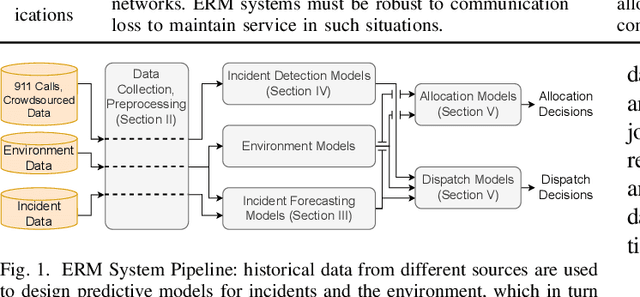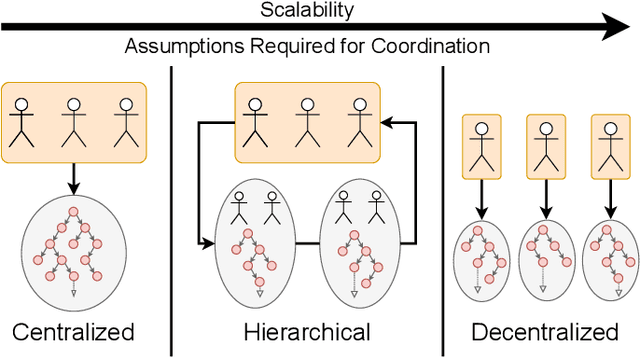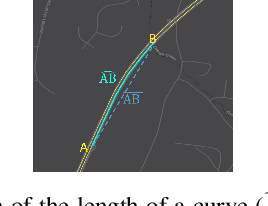Sayyed Mohsen Vazirizade
Designing Decision Support Systems for Emergency Response: Challenges and Opportunities
Mar 13, 2022


Abstract:Designing effective emergency response management (ERM) systems to respond to incidents such as road accidents is a major problem faced by communities. In addition to responding to frequent incidents each day (about 240 million emergency medical services calls and over 5 million road accidents in the US each year), these systems also support response during natural hazards. Recently, there has been a consistent interest in building decision support and optimization tools that can help emergency responders provide more efficient and effective response. This includes a number of principled subsystems that implement early incident detection, incident likelihood forecasting and strategic resource allocation and dispatch policies. In this paper, we highlight the key challenges and provide an overview of the approach developed by our team in collaboration with our community partners.
Practitioner-Centric Approach for Early Incident Detection Using Crowdsourced Data for Emergency Services
Dec 03, 2021



Abstract:Emergency response is highly dependent on the time of incident reporting. Unfortunately, the traditional approach to receiving incident reports (e.g., calling 911 in the USA) has time delays. Crowdsourcing platforms such as Waze provide an opportunity for early identification of incidents. However, detecting incidents from crowdsourced data streams is difficult due to the challenges of noise and uncertainty associated with such data. Further, simply optimizing over detection accuracy can compromise spatial-temporal localization of the inference, thereby making such approaches infeasible for real-world deployment. This paper presents a novel problem formulation and solution approach for practitioner-centered incident detection using crowdsourced data by using emergency response management as a case-study. The proposed approach CROME (Crowdsourced Multi-objective Event Detection) quantifies the relationship between the performance metrics of incident classification (e.g., F1 score) and the requirements of model practitioners (e.g., 1 km. radius for incident detection). First, we show how crowdsourced reports, ground-truth historical data, and other relevant determinants such as traffic and weather can be used together in a Convolutional Neural Network (CNN) architecture for early detection of emergency incidents. Then, we use a Pareto optimization-based approach to optimize the output of the CNN in tandem with practitioner-centric parameters to balance detection accuracy and spatial-temporal localization. Finally, we demonstrate the applicability of this approach using crowdsourced data from Waze and traffic accident reports from Nashville, TN, USA. Our experiments demonstrate that the proposed approach outperforms existing approaches in incident detection while simultaneously optimizing the needs for real-world deployment and usability.
Learning Incident Prediction Models Over Large Geographical Areas for Emergency Response Systems
Jun 15, 2021



Abstract:Principled decision making in emergency response management necessitates the use of statistical models that predict the spatial-temporal likelihood of incident occurrence. These statistical models are then used for proactive stationing which allocates first responders across the spatial area in order to reduce overall response time. Traditional methods that simply aggregate past incidents over space and time fail to make useful short-term predictions when the spatial region is large and focused on fine-grained spatial entities like interstate highway networks. This is partially due to the sparsity of incidents with respect to the area in consideration. Further, accidents are affected by several covariates, and collecting, cleaning, and managing multiple streams of data from various sources is challenging for large spatial areas. In this paper, we highlight how this problem is being solved for the state of Tennessee, a state in the USA with a total area of over 100,000 sq. km. Our pipeline, based on a combination of synthetic resampling, non-spatial clustering, and learning from data can efficiently forecast the spatial and temporal dynamics of accident occurrence, even under sparse conditions. In the paper, we describe our pipeline that uses data related to roadway geometry, weather, historical accidents, and real-time traffic congestion to aid accident forecasting. To understand how our forecasting model can affect allocation and dispatch, we improve upon a classical resource allocation approach. Experimental results show that our approach can significantly reduce response times in the field in comparison with current approaches followed by first responders.
 Add to Chrome
Add to Chrome Add to Firefox
Add to Firefox Add to Edge
Add to Edge